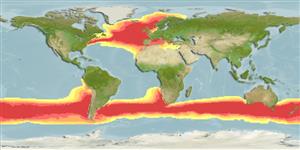Classificação / Names
Common names from other countries
Referência principal
Tamanho / Peso / Idade
Max length : 350 cm TL macho/indeterminado; (Ref. 4645); common length : 244 cm TL macho/indeterminado; (Ref. 5951); Peso máx. publicado: 230.0 kg (Ref. 40637); Idade máx. registada: 30 anos (Ref. 247)
Length at first maturity
Lm 175.0, range 170 - 180 cm
Ambiente
; marinhas; oceanódromo (Ref. 51243); intervalo de profundidade 0 - 715 m (Ref. 26346)
Clima / Intervalo
Temperate; 1°C - 18°C (Ref. 6871), preferred 17°C (Ref. 107945); 76°N - 59°S, 180°W - 180°E (Ref. 247)
Distribuição
Circumglobal, amphitemperature with centers of distribution in the North Atlantic and temperate water of the southern hemisphere; not in equatorial seas. Appendix III (Mediterranean) of the Bern Convention (2002). Appendix II of the Bonn Convention (2009).
Países | Áreas FAO | Ecossistemas | Ocorrências | Introduções
Descrição breve
Espinhos dorsais (total): 0; Raios dorsais moles (total): 0; Espinhos anais 0; Raios anais moles: 0. A stout, spindle-shaped shark with large black eyes, a sharp, conical snout, long gill slits, and small, smooth-edged, narrow teeth with side cusps (Ref. 5578, 88171). Strong keels on the caudal peduncle, short secondary keels on the caudal base, and a crescentic caudal fin; the insertion of the small second dorsal fin is above the insertion of the anal fin (Ref. 88171). Dark grey dorsally, white ventrally, without blotches (Ref. 6581, 43278); rear tip of 1st dorsal abruptly white (Ref. 5578).
Categoria na Lista Vermelha da IUCN (Ref. 115185)
Ameaça para o homem
Traumatogenic (Ref. 4690)
Utilização humana
Pescarias: espécies comerciais; peixe desportivo: sim
Ferramentas
Relatórios especiais
Descarregue XML
Fontes da internet
Estimates of some properties based on models
Phylogenetic diversity index
PD50 = 0.7813 many relatives (e.g. carps) 0.5 - 2.0 few relatives (e.g. lungfishes)
Nível Trófico
4.6 ±0.0 se; Based on diet studies.
Resiliência
Muito baixo, tempo mínimo de duplicação da população maior que 14 anos (K=0.12; tm=5; tmax=30; Fec=1-5)
Vulnerabilidade
Very high vulnerability (86 of 100)
Categoria de preço
